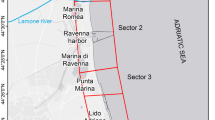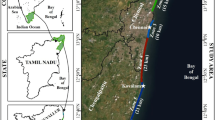Abstract
Shoreline change is an issue of concern to coastal stake holders because the coastal zone is home to over 60% of the world’s population. In Ghana, for instance, shoreline change has been associated with loss of economic lands and properties. Previous researches have showed that the coastline is eroding at variable rates in spatial times. Studies have also shown that shoreline change trends vary in geologic time scale, such that erosion or accretion is reversible along same shore at different time periods. The Eastern and Central Zones of the Ghanaian coast are said to be receding while the Western Zone is thought of as stable. This opinion, however, contrasts field observations and interview with local coastal community members. This research sought to determine the shoreline change trends in the study area over short-term (1974–2005) and long-term (1895–2005) interval so as to ascertain the variability of shoreline trends to aid future prediction. From available multi-temporal datasets of topographic maps and ortho photographs, the shoreline feature was extracted using the High Water Line (HWL) as an indicator. From which the shoreline time series datasets were overlaid before transects cast using DSAS an extension of ArcGIS. The shoreline change statistics were computed analysed. The results show a mean rate change of - 4.18 m/year for the entire study area, while the Western Section recorded a mean of 5.4 m/year and the Eastern Section recorded a mean of 2.36 m/year. An average shoreline change rate of −6.55 m/year recorded for the entire study area in the long term analysis. The Eastern Section is eroding at a rate of −2.18 m/year while a portion of the Western Section registered highest change rates with a mean of −11.64 m/year. Examination of the short and long terms shoreline change trends revealed a condition of long period of irreversible recession of the shoreline with little accretion at most portions of the study area.





Similar content being viewed by others
References
AESC (Producer). (1988). Coastal Hazards. Retrieved from http://www.aesc.org
Alexandrakis G, Karditsa A, Poulos SE, Ghionis G, Kampanis NA (2008) An Assessment of the Vulnerability to Erosion by the Coastal Zone Due to Potential Rise of Sea Level: The Case of the Hellenic Aegean Coast (Vol. 3): Environmental Systems. Eolss Pub, Oxford
Al-Tahir R, Ali A (2004) Assessing land cover changes in the coastal zone using AerialPhotography. Surveying Land Inf Sci 64(2):107–112
Appeaning Addo K, Walkden MJ, Mills JP (2008) Detection, measurement and prediction of shoreline recession in Accra, Ghana. J Photogramm Remote Sens 63(5):543–558
Appeaning Addo K, Larbi L, Amisigo B, Ofori-Danso PK (2011) Impacts of coastal inundation due to climate change in a cluster of urban coastal communities in Ghana, West Africa. Remote Sens 3(9):2029–2050
BeachMED (2008). Beach erosion monitoring (pp. 233). Beachmed-e/Optimal Project, Florence
Bird ECF (2008) Coastal geomorphology: an introduction, 2nd edn. Wiley, Chichester
Boye CB, Appeaning Addo K, Williams EA (2016) Positional accuracy assessment for effective shoreline change analyses. Ghana Min J 16(1):1–7
Bray MJ, & Hooke JM (1997). Prediction of soft-cliff retreat with accelerating sea-level rise. J Coast Res, 453–467
Church J, Wilson S, Woodworth P, & Aarup T (2006). Understanding Sea-level rise and variability, Vol. 15 (pp. 12-18). UNESCO Workshop, Paris
Corbella S, Stretch DD (2012) Decadal trends in beach morphologyon the east coast of South Africa and likely causative factors. Nat Hazards Earth Syst Sci 12:2515–2527
Dean R, Dalrymple RA (2002) Coastal processes with engineering applications. University Press, Cambridge
Dehouch A (2004) Monitoring shoreline change from aerial near-vertical photographies: Towards knowledge of the dynamic context along the West Brittany sandy coast. Proceedings of the 7th international symposium on delivering sustainable coasts; connecting science and policy, Aberdeen, Scotland
Dolan R, Fenster MS, Holme SJ (1991) Temporal analysis of shoreline recession and accretion. J Coast Res 7(3):723–744
Frazer LN, Genz AS, & Fletcher CH (2009). Toward parsimony in shoreline change Prediction (I): Basis Function Methods. Journal of Coastal Research, 25(2), 366-379.
Galgano FA, Douglas BC (2000) Shoreline position prediction: methods and errors. Environ Geosci 7(1):1–10
Hapke CJ, Reid D, Richmond BM, Ruggiero P (2006) National assessment of shoreline change Part 3: Historic shoreline change and associated coastal land loss along sandy shorelines of the Califor Geological survey open report
Hinrichsen D (1998) Coastal waters of the world: trends, threats, and strategies. Island Press, Washington D.C
Kesse GO (1985). The Mineral and rock Resources of Ghana. Balkema, Rotterdam: Ghana Geological Survey
Kumar VS, Anand NM, Chandramohan P, Naik GN (2003) Longshore sediment transport rate - measurement and estimation, central west coast of India. Coast Eng 48(1):95–109
Loh, G. & Hirdes, W. (1999). Explanatory notes for the geological map of the Southwest Ghana. Bulletin No. 49. Ghana Geological Survey, Republic of Ghana 149p
Ly CK (1980) The role of the Akosombo dam on the Volta River in causing coastal erosion in central and eastern Ghana (West Africa). Mar Geol 37:323–332
Mensah JV (1997) Causes and effects of coastal sand Mining in Ghana. Singap J Trop Geogr 18(1):69–88
Morton RA (1997) Historic shoreline changes and their causes, Texas gulf coast. Assoc Geol Soc Trans 27:353–364
Olympio GFA, Amos-Abanyie S (2013) Effects of shoreline erosion on infrastructure development along the Coastal Belt of Ghana: case of Nkontompo community. J Sci Technol 33(3):39–50
Sagoe-Addy K, & Addo K A (2013). Effect of predicted sea level rise on tourism facilities along Ghana’s Accra coast. Journal of coastal conservation, 17(1), 155-166
Stewart, H. R. (2008). Introduction to physical oceanography. Texas A & M University, Texas
Thieler ER, Himmelstoss EA, Zichichi JL, Ergul A (2009) Digital shoreline analysis system (DSAS) version 4.0— an ArcGIS extension for calculating shoreline change: U.S. Geological Survey Open-File Report 2008–1278
van der Linden PJ, Hanson CE (2007). Climate change 2007: impacts, adaptation and vulnerability (Vol. 4). In: Parry ML, Canziani O, Palutikof J (Eds.). Cambridge: Cambridge University Press.
Vassie JM, Woodworth PL, Holt MW (2004) An example of North Atlantic deep-ocean swells impacting Ascension and St. Helena Islands in the central South Atlantic. J Atmos Ocean Technol 21:1095–1103
WHOI (2014). Shoreline change and the importance of coastal erosion. Wood Hole Oceanography Institutes, Wood Hole
Wiafe, G., Boateng, I., Addo-Appeaning, K., Quashigah, P. N., Ababio, S. D., & Sowah, L. (2013). Handbook of coastal processes and Management in Ghana. The Choir Press in conjunction with Coastal Processes Research Group, Accra
Woodroffe CD (2003) Coasts: form, process and evolution. University Press, Cambridge
Zhang K, Douglas BC, Leatherman SP (2004) Global warming and coastal erosion. Clim Chang 64:41–58
Author information
Authors and Affiliations
Corresponding author
Rights and permissions
About this article
Cite this article
Boye, C.B., Appeaning Addo, K., Wiafe, G. et al. Spatio-temporal analyses of shoreline change in the Western Region of Ghana. J Coast Conserv 22, 769–776 (2018). https://doi.org/10.1007/s11852-018-0607-z
Received:
Revised:
Accepted:
Published:
Issue Date:
DOI: https://doi.org/10.1007/s11852-018-0607-z




